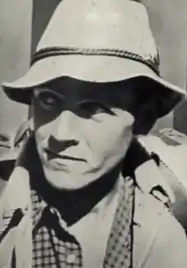 | |
| Personal information | |
|---|---|
| Nickname | Edi Rainer |
| Nationality | Austrian |
| Born | 1914 |
| Died | 21 July 1936 (aged 21–22) Eiger, Bernese Alps, Switzerland |
| Climbing career | |
| Known for | 1936 Eiger north face climbing disaster |
Eduard Rainer (1914 – 21 July 1936) was an Austrian mountaineer. He was one of the four climbers who died in the 1936 Eiger north face climbing disaster, along with Toni Kurz, Andreas Hinterstoisser and Willy Angerer.[1]
Reconnoiter
The two Austrians, Rainer and Angerer, knew that the German duo, Max Sedlmayer and Karl Mehringer had spent a long time on the First Band during their fatal attempt in 1935.[2] On 6 July 1936 Rainer and Angerer ventured out and decided to search for a line that would bring them to the Rote Fluh from where they intended to reach the First Icefield. They retreated because of the wet icy conditions.[3]
Eiger north face climb
On 18 July 1936 Eduard Rainer and his friend Willy Angerer commenced their attempt on the north face of the Eiger, which was then one of the last great Alpine north faces remaining to be conquered.[4] At almost the same time the German mountaineers, Toni Kurz and Andreas Hinterstoisser, were making the same attempt.[3]
The German pair were the first to reach a difficult section that required a pendulum action, called a tension traverse, to get across the steep rock face. Hinerstoisser was the one to overcome the obstacle which is why it is now known as the Hinterstoisser traverse. When the Austrian pair had come through they made a fatal mistake. They pulled the rope through leaving no possibility of reversing their route.[4]

At this stage the four climbers combined into one team and continued their ascent to the "Death Bivouac", where Sedlmayer and Mehringer were last seen from Kleine Scheidegg the previous year.[4]
During their overnight bivouac the weather turned bad and the steep wall became iced over. Despite the weather, the team continued ascending until Angerer was hit in the head by rockfall and they decided to retreat. By now the Hinterstoisser traverse was iced over and without a rope in place to aid their retreat there was no choice but to abseil down handicapped by the injured Angerer.
While abseiling, the group were hit by a stone and ice avalanche that pulled Rainer up against the piton belay where the rock shattered his chest.[3] Neither Angerer and Hinterstoisser survived the disaster leaving only Toni Kurz alive.[5] The following day Kurz died almost within reach of a rescue team but for his inability to pass the knotted abseil rope, that had been dropped down by rescuers, through a carabiner with his frozen fingers.[4]
Legacy
The climb is recalled in the 2007 drama documentary The Beckoning Silence inspired by climber Joe Simpson's book of the same name[6] and again in the 2008 feature film North Face directed by Philipp Stölzl.[7]
References
- ↑ Grindelwald: The Eiger (PDF), Jungfrau Region Marketing AG, pp. 1, 3, archived from the original (PDF) on 2015-05-23, retrieved 2016-12-28
- ↑ Wright, Jeff (22 April 2020). "The Eiger North Face". Alpine Vagabonds. Retrieved 7 October 2020.
- 1 2 3 Gillman, Peter (4 June 2015). Extreme Eiger: The Race to Climb the Direct Route up the North Face of the Eiger. London: Simon & Schuster. p. 30. ISBN 978-1-47113-460-9.
- 1 2 3 4 Gilbert, Dave (3 September 2001). "Eiger's grim reputation". BBC News. Archived from the original on 4 February 2008. Retrieved 12 August 2020.
- ↑ Granbacher, Christian (5 February 2017). "Die 1.800 Meter Wand". ECHO Salzburg (in German). Archived from the original on 5 February 2017. Retrieved 7 October 2020.
- ↑ Douglas, Ed (17 September 2010). "The 10 best survival stories". The Guardian. Retrieved 30 November 2020.
- ↑ Ebert, Roger (24 February 2010). "The unforgiving logic of mountain climbing". Reviews. RogerEbert.com. Retrieved 30 November 2020.
Further reading
- Harrer, Heinrich (1998). The White Spider. New York: Penguin Putnam. pp. 31–51. ISBN 0-87477-940-5
External links
- Echo Online Wayback Machine archived link (in German)
- The Beckoning Silence at IMDb
- North Face at IMDb